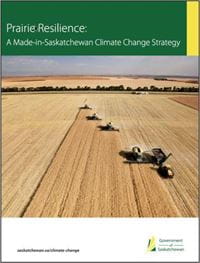Prairie Resilience
The province launched its climate change strategy, Prairie Resilience: A Made-in-Saskatchewan Climate Change Strategy, in December 2017. The strategy employs natural systems and technological innovation to reduce greenhouse gas emissions while protecting our competitiveness, prioritizing affordability, and enhancing sustainable growth and development. Prairie Resilience is a practical strategy that seeks to make Saskatchewan more resilient to the effects of a changing climate while recognizing that climate change cannot be effectively addressed without the resources provided by a strong, sustainable economy. Prairie Resilience has an integral role in Saskatchewan’s Growth Plan by encouraging actions that enhance sustainable growth.
Under Prairie Resilience, Saskatchewan is reducing emissions through a range of agricultural practices, including the sequestration of carbon through zero and low tillage, the use of 4R nutrient stewardship to promote efficient fertilizer application, and the reduction of methane through use of innovative animal feed. Through Prairie Resilience, Saskatchewan also introduced the Methane Action Plan (MAP) which, along with Output-Based Performance Standards Program, has reduced GHG emissions from venting and flaring in the upstream oil and gas industry by 67 per cent since 2015.
Technological innovation also plays a key role in our climate change strategy. For example, the province’s support for carbon capture, utilization and storage (CCUS) is expected to encourage $2 billion in investment and sequester over two million tonnes of CO2 each year. Saskatchewan is a world leader in enhanced oil recovery (EOR) carbon capture, which emits 37 per cent fewer emissions than traditional extraction methods. Over the last 25 years, Saskatchewan’s EOR projects have sequestered more than 40 million tonnes of CO2.
Saskatchewan’s Output-Based Performance Standards (OBPS) Program is the province’s industrial emissions pricing system and another key component of Prairie Resilience. The OBPS Program is designed to reduce industrial emissions while protecting economic competitiveness by preventing carbon leakage - when production moves to jurisdictions with less stringent environmental regulations.
Under Prairie Resilience, the province’s OBPS Program requires reductions in emissions intensity across most sectors of the economy. Effective January 1, 2023, changes to the OBPS Program increased emission reduction requirements, expanded the number of facilities and emissions covered under the program, and introduced a CCUS credit program that will further incentivize reductions in industrial emissions.
OBPS-regulated industrial emitters that go over their permitted emission levels must either purchase and/or retire performance credits or pay compliance into the Saskatchewan Technology Fund. This fund uses a competitive application process to support industry-driven initiatives that reduce emissions at regulated facilities.
To date, the OBPS Program has been highly effective:
- The OBPS Program is expected to save regulated emitters over $1.6 billion for 2019-22 and $14 billion by 2030 compared to the federal carbon pricing backstop.
- 100 per cent of regulated emitters have met their compliance obligations under the OBPS program.
- The Saskatchewan Technology Fund launched its first intake in September 2023, making $25 million available to support industry-driven projects to reduce emissions intensity.
Saskatchewan’s Affordable Power Plan
The province is undertaking a series of initiatives to achieve a net-zero electricity grid by 2050 – a realistic and achievable timeline that will allow the province to decarbonize the grid while ensuring Saskatchewan households and businesses have access to affordable, reliable electricity.
As part of the affordable power plan, Saskatchewan will continue to use a mix of energy sources that ensure reliable baseload power, including natural gas, while increasing use of renewables such as wind and solar.
The affordable power plan also includes use of OBPS compliance payments from the electricity sector to support SaskPower’s transition to a clean power grid, with a dedicated investment fund to deploy Saskatchewan’s first small modular reactor.
Other initiatives that support the transition to a lower carbon economy include:
- The release of Saskatchewan’s Critical Minerals Strategy in March 2023, which aims to double the number of critical minerals being produced in Saskatchewan by 2030. This will enable Saskatchewan to play a key role in supporting the transition to a lower carbon economy.
- Establishing the Saskatchewan Research Council Rare Earth Processing Facility in Saskatoon, which will process rare earth elements used in the production of clean electricity technologies, like electric vehicles.
- Ongoing work to build on Saskatchewan’s 2021 carbon capture utilization and storage (CCUS) priorities. This includes introducing CCUS credits to encourage OBPS-regulated emitters to adopt CCUS technology.
The province also contributes to global emission reductions by providing international markets with a wide range of sustainable, lower-emission products, including food, fuel and fertilizer. As outlined on the Sustainable Saskatchewan website, the province employs sustainable land use practices, progressive environmental regulations, and innovative technology to strengthen Saskatchewan’s resilience to climate change while becoming a world leader in sustainable economic development and environmental stewardship.


